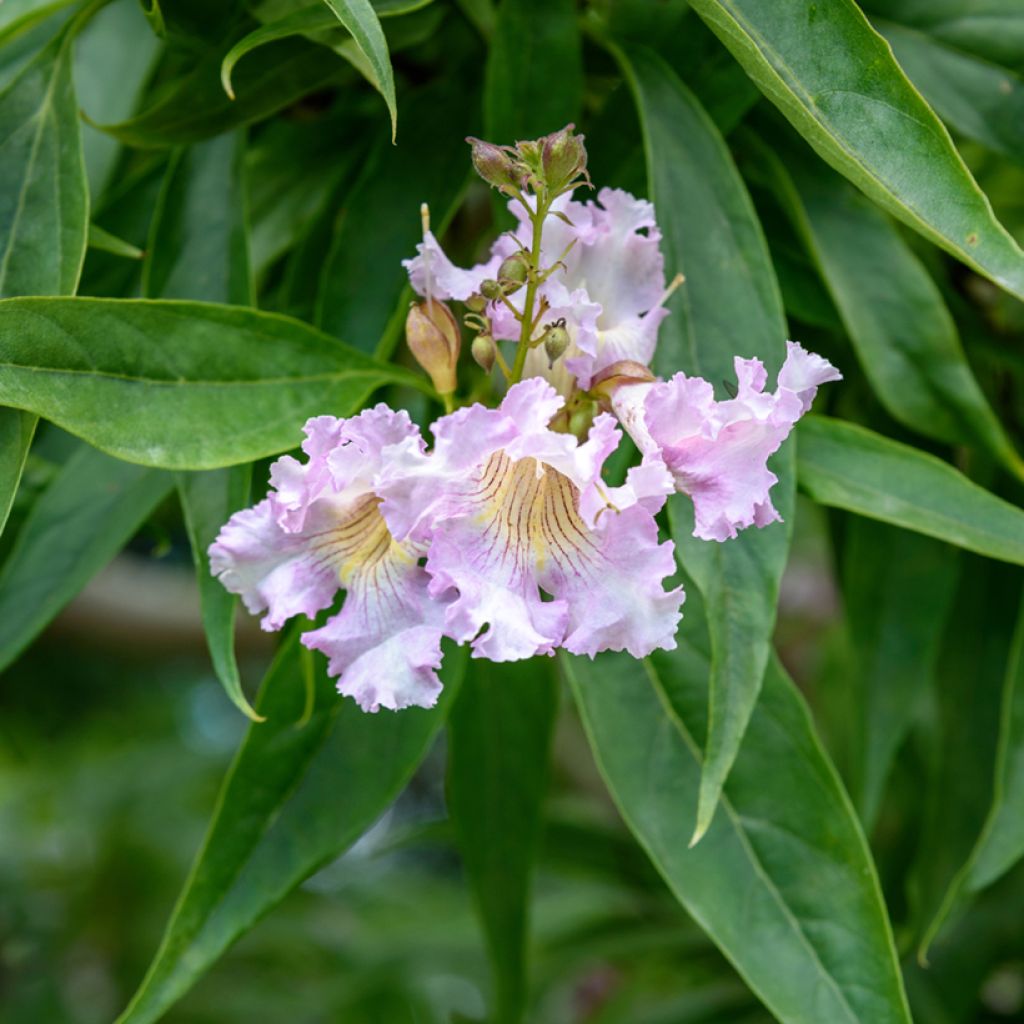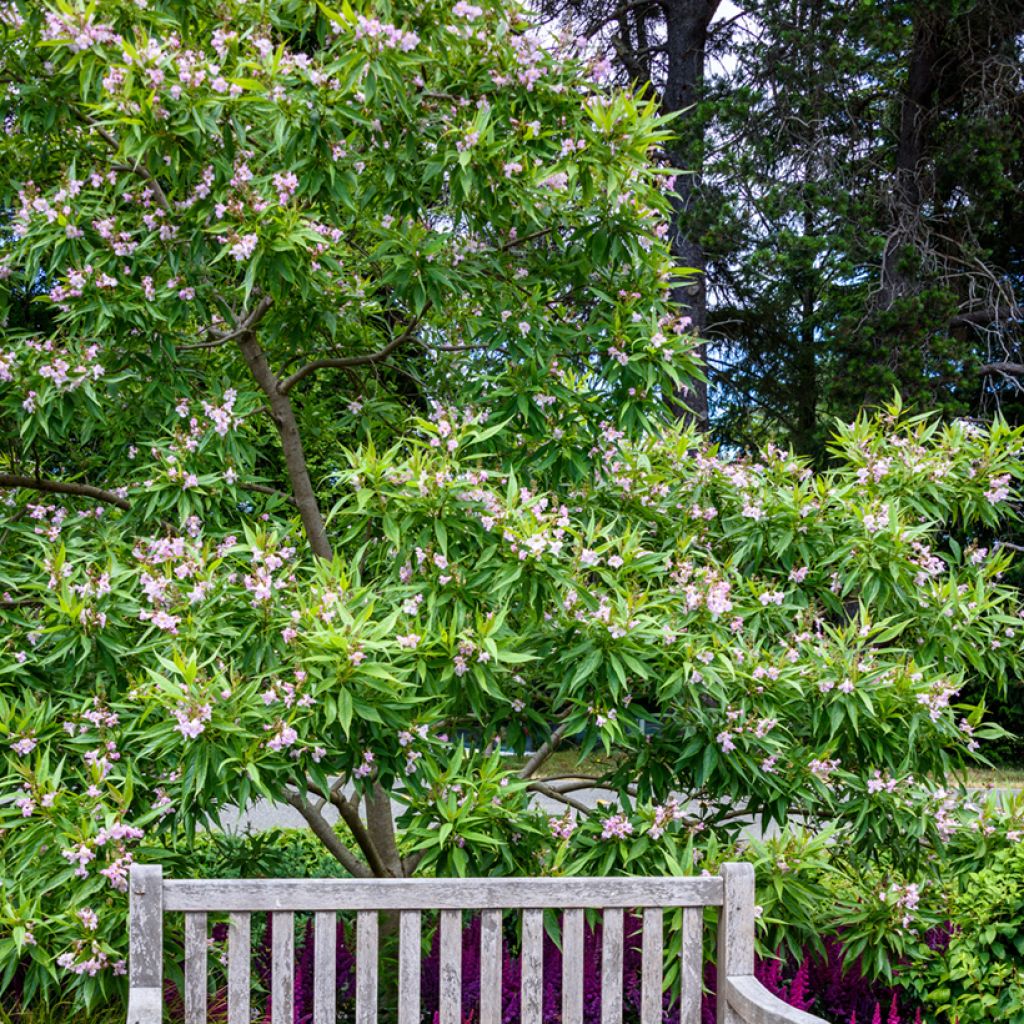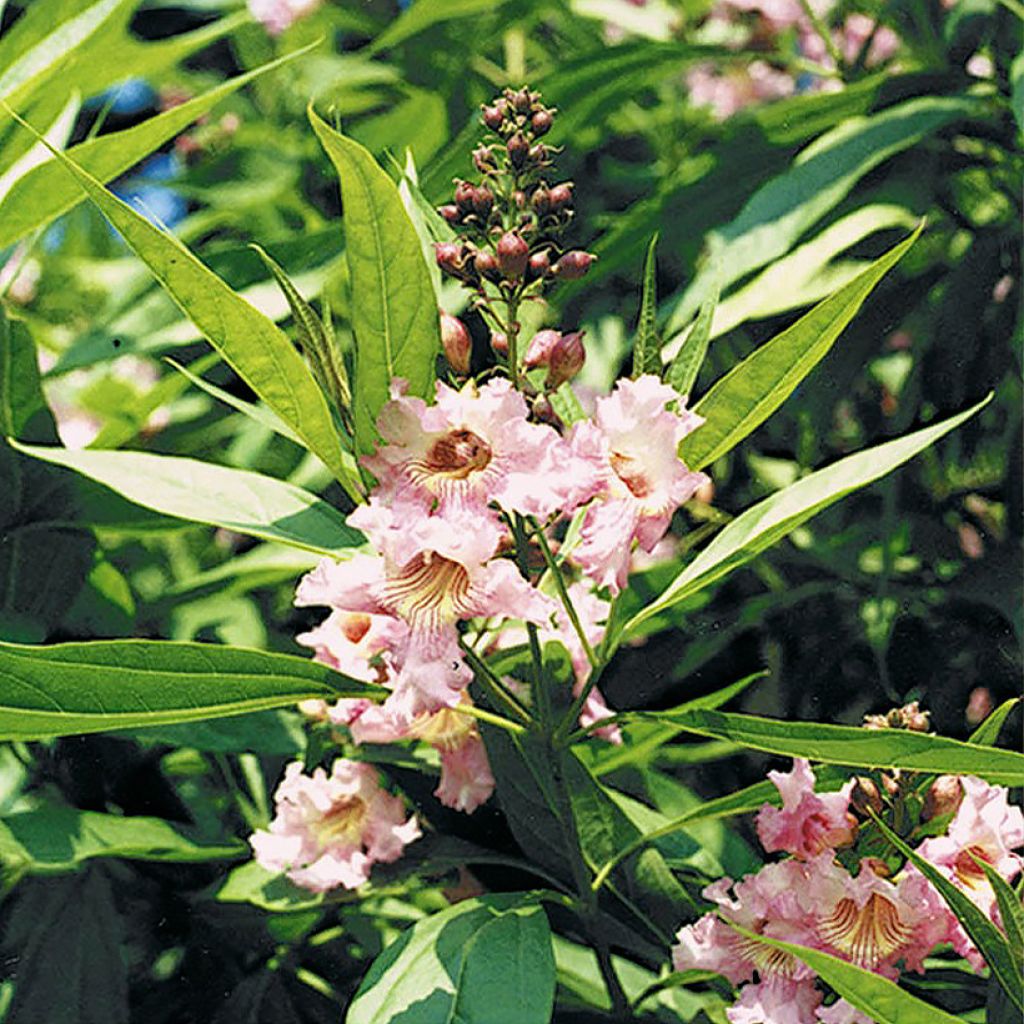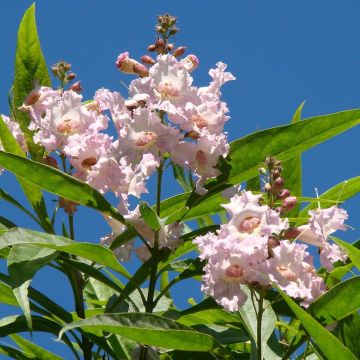

Chitalpa tashkentensis Pink Dawn


Chitalpa tashkentensis Pink Dawn


Chitalpa tashkentensis Pink Dawn
Chitalpa tashkentensis Pink Dawn
Chitalpa tashkentensis Pink Dawn
This item cannot be shipped to the selected country
Delivery charge from €5.90
Delivery to Corse prohibited
More information
Schedule delivery date,
and select date in basket
This plant carries a 24 months recovery warranty
More information
We guarantee the quality of our plants for a full growing cycle, and will replace at our expense any plant that fails to recover under normal climatic and planting conditions.
From €5.90 for pickup delivery and €6.90 for home delivery
Express home delivery from €8.90.
Delivery to Corse prohibited: UE law prohibits the import of this plant from mainland France to Corse as part of the fight against Xylella fastidiosa. Please accept our sincere apologies.
More information
Does this plant fit my garden?
Set up your Plantfit profile →
Description
The Chitalpa tashkentensis 'Pink Dawn' or Tashkent Chitalpa is an interesting ornamental tree for its spectacular summer flowering, fast growth, and resistance to both cold and drought. This hybrid between Catalpa bignonoides and Chilopsis linearis has a gently exotic appearance that is impossible to ignore. Its size allows it to fit well in a medium-sized garden, and it requires no maintenance once established.
Chitalpa tashkentensis is a hybrid obtained through spontaneous cross-breeding of Chilopsis linearis (desert willow) with Catalpa bignonioides (common catalpa). It was discovered in the Tashkent province in Uzbekistan and then multiplied "in vitro" in the 1960s-1964s. This large, sterile shrub belongs to the Bignoniaceae family. It is a plant that perfectly withstands both cold temperatures (up to -20°C) and dry summers. Chitalpa tolerates limestone well and prefers deep, well-drained soils.
The Chitalpa tashkentensis 'Pink Dawn' was selected in the USA. It is a fast-growing tree that reaches a height and width of 6 to 7 meters. It has a spreading habit and a wide, spherical crown. The relatively small, matte green leaves, measuring 10 to 15 cm long, give the tree a delicate structure. These are deciduous leaves that fall in autumn.
The flowers of the 'Pink Dawn' Chitalpa are one of its best features. They appear in panicles of 15 to 40 flowers, from May to late August, with a possible rebloom in September if the temperatures are warm. Each trumpet-shaped flower measures between 2.5 and 5 cm in diameter. They have a lavender-pink colour washed with white, a light yellow throat, and purple streaks. These flowers attract various pollinators. Unlike many trees, the 'Pink Dawn' Chitalpa is sterile and therefore does not produce any fruits. The bark of this tree is grey-brown and slightly channelled, adding an interesting texture to the trunk and branches. Adapted to warm climates, this 'Pink Dawn' Chitalpa shows less vigorous growth in colder regions. This tree prefers full sun and well-drained soils, even limestone soils. It is relatively resistant to diseases but can be sensitive to mildew in very humid environments. This tree can be pruned as a coppice shoots, meaning it can be cut close to the base as it regrows from the stump.
The Chitalpa tashkentensis 'Pink Dawn' is perfect for adding an exotic and colourful touch to the garden without requiring much care. It can be paired with plants that have similar soil and exposure needs. In warm regions, plant it in the centre of a bed composed of Lavandula angustifolia 'Rosea' (Lavender), Salvia microphylla 'Cerro Potosi' (Bush sage), and Rosmarinus officinalis 'Pointe du Raz' (Rosemary). In colder climates, create a border with Rosa 'Happy Chappy' (Ground cover rose) and Nepeta 'Kit Kat' (Catnip) to surround your Chitalpa.
Report an error about the product description
Plant habit
Flowering
Foliage
Botanical data
Chitalpa
tashkentensis
Pink Dawn
Bignognaceae
Chitalpa x tashkentensis 'Pink Dawn'
Cultivar or hybrid
Other Chitalpa and Chilopsis
Planting and care
The Chitalpa tashkentensis 'Pink Dawn' can be planted from March to May (in cold regions) or from September to November in hot and dry climates. It can tolerate regular garden soil, but it prefers well-drained, loose, deep soils, even if they are limestone-based. It is recommended to provide a complete fertilizer every year at the beginning of the growing season. The substrate should be kept moist during the first few years of cultivation, but this small tree can go without watering in the summer, even in hot and dry climates. It is best to plant it in full sun, as its flowering is better when it receives maximum light. A light pruning may be necessary for training (such as shaping it into a standard or tree form) in winter. To achieve a very bushy specimen, it can be pruned back in late winter without affecting flowering. The vegetation of this shrub restarts late, in the month of May.
Planting period
Intended location
Care
This item has not been reviewed yet - be the first to leave a review about it.
Haven't found what you were looking for?
Hardiness is the lowest winter temperature a plant can endure without suffering serious damage or even dying. However, hardiness is affected by location (a sheltered area, such as a patio), protection (winter cover) and soil type (hardiness is improved by well-drained soil).

Photo Sharing Terms & Conditions
In order to encourage gardeners to interact and share their experiences, Promesse de fleurs offers various media enabling content to be uploaded onto its Site - in particular via the ‘Photo sharing’ module.
The User agrees to refrain from:
- Posting any content that is illegal, prejudicial, insulting, racist, inciteful to hatred, revisionist, contrary to public decency, that infringes on privacy or on the privacy rights of third parties, in particular the publicity rights of persons and goods, intellectual property rights, or the right to privacy.
- Submitting content on behalf of a third party;
- Impersonate the identity of a third party and/or publish any personal information about a third party;
In general, the User undertakes to refrain from any unethical behaviour.
All Content (in particular text, comments, files, images, photos, videos, creative works, etc.), which may be subject to property or intellectual property rights, image or other private rights, shall remain the property of the User, subject to the limited rights granted by the terms of the licence granted by Promesse de fleurs as stated below. Users are at liberty to publish or not to publish such Content on the Site, notably via the ‘Photo Sharing’ facility, and accept that this Content shall be made public and freely accessible, notably on the Internet.
Users further acknowledge, undertake to have ,and guarantee that they hold all necessary rights and permissions to publish such material on the Site, in particular with regard to the legislation in force pertaining to any privacy, property, intellectual property, image, or contractual rights, or rights of any other nature. By publishing such Content on the Site, Users acknowledge accepting full liability as publishers of the Content within the meaning of the law, and grant Promesse de fleurs, free of charge, an inclusive, worldwide licence for the said Content for the entire duration of its publication, including all reproduction, representation, up/downloading, displaying, performing, transmission, and storage rights.
Users also grant permission for their name to be linked to the Content and accept that this link may not always be made available.
By engaging in posting material, Users consent to their Content becoming automatically accessible on the Internet, in particular on other sites and/or blogs and/or web pages of the Promesse de fleurs site, including in particular social pages and the Promesse de fleurs catalogue.
Users may secure the removal of entrusted content free of charge by issuing a simple request via our contact form.
The flowering period indicated on our website applies to countries and regions located in USDA zone 8 (France, the United Kingdom, Ireland, the Netherlands, etc.)
It will vary according to where you live:
- In zones 9 to 10 (Italy, Spain, Greece, etc.), flowering will occur about 2 to 4 weeks earlier.
- In zones 6 to 7 (Germany, Poland, Slovenia, and lower mountainous regions), flowering will be delayed by 2 to 3 weeks.
- In zone 5 (Central Europe, Scandinavia), blooming will be delayed by 3 to 5 weeks.
In temperate climates, pruning of spring-flowering shrubs (forsythia, spireas, etc.) should be done just after flowering.
Pruning of summer-flowering shrubs (Indian Lilac, Perovskia, etc.) can be done in winter or spring.
In cold regions as well as with frost-sensitive plants, avoid pruning too early when severe frosts may still occur.
The planting period indicated on our website applies to countries and regions located in USDA zone 8 (France, United Kingdom, Ireland, Netherlands).
It will vary according to where you live:
- In Mediterranean zones (Marseille, Madrid, Milan, etc.), autumn and winter are the best planting periods.
- In continental zones (Strasbourg, Munich, Vienna, etc.), delay planting by 2 to 3 weeks in spring and bring it forward by 2 to 4 weeks in autumn.
- In mountainous regions (the Alps, Pyrenees, Carpathians, etc.), it is best to plant in late spring (May-June) or late summer (August-September).
The harvesting period indicated on our website applies to countries and regions in USDA zone 8 (France, England, Ireland, the Netherlands).
In colder areas (Scandinavia, Poland, Austria...) fruit and vegetable harvests are likely to be delayed by 3-4 weeks.
In warmer areas (Italy, Spain, Greece, etc.), harvesting will probably take place earlier, depending on weather conditions.
The sowing periods indicated on our website apply to countries and regions within USDA Zone 8 (France, UK, Ireland, Netherlands).
In colder areas (Scandinavia, Poland, Austria...), delay any outdoor sowing by 3-4 weeks, or sow under glass.
In warmer climes (Italy, Spain, Greece, etc.), bring outdoor sowing forward by a few weeks.




































